
CBT Therapy Treatment for Intrusive Thoughts
Cognitive Behavioural Therapy (CBT therapy) Treatment for
Intrusive Thoughts or Pure O
Sue’s Story
This case study was written to show how effective CBT Therapy Treatment is for Intrusive Thoughts.
Sue* is a professional dance choreographer in her mid-thirties who lives with her partner and her dog in Greenwich, London.
Nine months ago Sue was walking the dog in her local park when she saw some children playing football. Suddenly out of nowhere, an image came into her head that disgusted her and she found it morally reprehensible.
Sue tried to get the thought to leave her head but it just wouldn’t go away. Over the next few weeks, more horrible and distressing thoughts of a similar nature kept coming into her Mind.
“They would plague me for hours and always be at the back of my mind – I thought I was going crazy or turning into someone I despised”
Everything she tried to “banish the thoughts from her mind” just wasn’t working. She got very scared and that was the point when she reached out to the CBT Clinic London for help. She searched on Google and found that the most effective way to treat Intrusive Thoughts was Cognitive Behavioural Therapy or CBT Therapy.
“Everything I tried to get rid of these frightening and horrible images just wasn’t working”.
CBT Therapy Treatment for Intrusive Thoughts
Sue was assessed by one of our Senior CBT Therapists at the CBT Clinic London who reassured Sue that these thoughts were completely treatable and would not be a feature for the rest of her life. In fact, they were so common that the media had termed them “Pure O” a form of OCD.
“I was greatly relieved to hear this as some of the forums and articles I had found online had said that I would have to live with these distressing thoughts for the rest of my life. “
Sue’s treatment plan was informed by the highly effective and clinically validated* CBT Therapy Model for the treatment of OCD. (see below)*

Although most people in Sue’s case are not doing any “outside world” compulsions which often are present in a classic OCD case the CBT Therapy Model for OCD (see below) is always the one we use said Alistair Bond one of the Senior CBT Therapists at the CBT Clinic London. Often we find that although sufferers of “Pure O” are not doing outward compulsions they are often or always doing inward compulsions. In Sue’s case, just one of the inward compulsions she was engaging in was counting backwards from 100 when the distressing images would intrude into her mind.
Once her treatment was concluded Sue’s distressing Intrusive Thoughts had completely gone away and her anxiety had returned to normal.
“I am so grateful to the clinic and in particular to Alistair Bond. He taught me why and how to accept the images and thoughts and how to reduce and eventually overtime, completely stop the mental compulsions. I learnt to work on the obstacles and barriers inside of me that were stopping me from being able to accept these very difficult and upsetting thoughts. Eventually overtime I was able to accept and learn from the thoughts until one beautiful day they just left me. “
The Clinical Measures we use at the clinic allow us to see Sue’s anxiety had reduced by 90% using Sue’s self-reported scores from when she entered treatment to when she exited treatment, She also reported no further intrusions.
As is our policy at the clinic we always do a 3-month and 6 month follow up. This is best practice in CBT Therapy. We are pleased to report that at the 3 and 6 month follow ups Sue reported no further intrusions and her anxiety had consistently been improving.
“CBT Therapy is amazing for helping you with “Pure O” and OCD. If you haven’t tried it yet my best advice is give it a go, you definitely won’t regret it!”
CBT Therapist London
This article was curated by Alistair Bond – Senior CBT Therapist in London. He is the Clinical Director of the CBT Clinic London and he specialises in treating “Pure O” and OCD.
If you or a loved one are struggling with intrusive thoughts, please get in touch with us. You call our friendly reception on 0207 157 9924, email info@cbtcliniclondon.com or simply fill out our new patient registration form and we’ll get back to you.
We offer CBT Therapy either Online or Face to Face in our London Clinic. We also offer the option to combine both to suit your lifestyle and preference.
*We thank Sue (name has been changed) for her kindness and generosity in sharing her success story to help and inspire others.
Learn More
Are you suffering with Intrusive Distressing Thoughts or Pure O? Here is a guide to help you?
What are Intrusive Thoughts?
Intrusive thoughts are unwanted, distressing thoughts that occur in people’s minds and repeat or worsen over time. Intrusive thoughts can often be disturbing, causing anxiety and fear. It is very common to have them when around or about loved ones. People often have intrusive thoughts about violence or sexual acts, which can keep people stuck in a vicious cycle. Intrusive thoughts are sudden and stressful. They can “come out of nowhere”. Almost always the thoughts are in direct contrast to people’s value systems and what they really want to be thinking about.
Intrusive thoughts can be mistaken for Obsessive Compulsive Disorder (OCD). OCD can cause intrusive thoughts but following a Programme of OCD targeted CBT Therapy can really help.
Of course, people without OCD can suffer from intrusive thoughts that do not disappear quickly. These thoughts can have lasting detrimental psychological effects usually due to their upsetting and distressing nature.
Are Intrusive Thoughts Normal?
Invasive thoughts are normal. Everyone has random, intrusive thoughts that have no bearing on what they’re doing or thinking. However, persistent, anxiety-inducing negative intrusive thoughts can be distressing and may affect your health and happiness. Seeking professional help will help.
What are the Most Common Intrusive Thoughts?
Intrusions do vary. Some people have disturbing thoughts about hurting themselves, while others worry about hurting others. Intrusive thoughts can hinder happiness, health, and fulfilment. They can cause severe stress, anxiety, and create career disruption if left untreated.
Some of the most common intrusive thoughts:
- Thoughts about hurting yourself, others, or violent scenarios
- Sexual acts or distressing sexual situations (like being attracted to children, family members, or rape)
- Your relationship (overanalysing innocent behaviour, paranoia about infidelity, finding faults in your partner)
- Religion
- Poisoning
- Self-criticism
- Sexuality

Pure O Specialists at the CBT Clinic London
Our specialists have decades of experience diagnosing and treating intrusive thoughts in top UK and international institutions. We know that the right treatment combination can transform lives, so our experts stay up to date on the latest psychological developments to provide you with the best care.
These are some of the most common intrusive thoughts, but the brain is a complex think tank, so you may have intrusive thoughts about personal events and situations that are not listed here. If you want to discuss any aspect of your intrusions please contact us here.
How are Intrusive Thoughts Treated?
Cognitive Behavioural Therapy (CBT Therapy), Mindfulness Meditation and Medication can all be used to treat intrusive thoughts. We’ll tailor a plan to your circumstances, medical history, and underlying conditions to help you live a balanced life free of intrusions.
The CBT Clinic London understands intrusive thoughts and can help. After assessing your symptoms, medical history, and frequency and duration, we can diagnose intrusive thoughts and help you live without them.
Schedule an appointment today to learn how you can master your intrusive thoughts. Your consultation will reveal your diagnosis and a customised treatment plan.
Book online with our intrusive thoughts treatment specialists. Register via our new patient form.
Online intrusive thoughts evaluation and diagnosis.
Prefer flexible payments? We offer payment plans.
How does The CBT Clinic London Treat Intrusive Thoughts?
The CBT Clinic London treats intrusive thoughts holistically. We’ll customise a treatment plan using Cognitive Behavioural Therapy (CBT Therapy), Mindfulness Meditation and Medication (when indicated).
We will first conduct a thorough assessment to determine the cause of your invasive thoughts. After a professional diagnosis, we will create a customised treatment plan to ensure the best therapeutic results. Medication may be part of your treatment.
Intrusive thoughts can make you feel out of control, so a good treatment plan can change your life.
What is the process?
1 -We start with a professional intrusive thoughts diagnosis and a personalised assessment report, which you can share with your GP, to ensure a perfect treatment plan.
2. – Our specialists will tailor a treatment plan to your therapy and medication needs. We know the benefits of each treatment and medication and can explain them to you during your appointment.
3. – We recommend follow-up appointments to review progress, discuss concerns and adjust medication doses to help intrusive thought patients recover.
Intrusive Thought Treatment London
After our thorough assessment and intrusive thoughts diagnosis, you’ll receive a tailored, balanced treatment plan to manage your symptoms and reduce the condition’s impact on your life.
Learn More
Pure O – All The Facts You Need To Know
Pure O – All The Facts You Need To Know
Purely Obsessional OCD, or Pure O as it’s more commonly referred to, is a form of OCD (Obsessive Compulsive Disorder) characterised by intrusive, uncontrollable thoughts or obsessions. Although someone experiencing Pure O may not display the more obvious behaviours associated with OCD such as hand-washing, arranging, cleaning and counting, the disorder is instead accompanied by hidden mental rituals.
Pure O is often seen as a less severe form of OCD however that is far from correct. For those experiencing the symptoms of Pure O, the intrusive thoughts that present can be extremely disruptive and distressing.
How Does Pure O differ from OCD?
Those with Puro O experience obsessions without any obvious behavioural compulsions however, they do still engage in mental and unseen rituals. By therapists and mental health professionals understanding these rituals and how they affect sufferers, they can then ask patients about these symptoms.
Often patients with these intrusive thoughts may be reluctant to discuss this and may not actually be aware that by acknowledging them, they can begin to take control of them.
What Are the Symptoms of Pure O?
The nature of Obsessive Compulsive Disorder means having recurring obsessions and displaying compulsive behaviours e.g having uncontrollable thoughts of germs and cleanliness which results in a com[pulsion to wash their hands repeatedly.
Those who experience OCD in a purely obsessional form still encounter a range of OCD symptoms however the outwardly obvious compulsions aren’t displayed. By definition, OCD is characterised by obsessions and compulsions. With Pure O these can be identified in the image below.
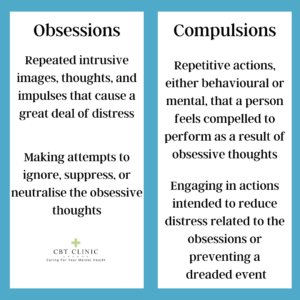
What Are Obsessions?
Obsessions can be described as recurring, persistent, intrusive and unwanted thoughts, images or urges which cause distress and anxiety. Obsessions often focus on somatic (related to the body), sexual, religious or aggressive thoughts. Concerns with symmetry, order and contamination can also be present.
What Are Compulsions?
Compulsions are repetitive behaviours or mental acts those with OCD are compelled to perform as a response to an obsession or perhaps, to satisfy a set of rules that govern their thoughts. Compulsions are excessive in comparison to typical reactions to thoughts and not connected realistically to the issue they’re intended to solve.
What Compulsions Are Associated with Pure O?
Intrusive thoughts may also be described as “unacceptable thoughts” or “taboo thoughts” which lead to obsessions and therefore compulsions. Individuals who experience Pure O obsessions engage in mental rituals in order to manage their distress and anxiety. These rituals could include:
- Mentally repeating certain words
- Mentally reviewing memories or information
- Mentally un-doing certain actions
As an example, a simple interaction at a supermarket with a stranger where the patient has mispronounced a word may be played out over and over mentally, with those experiencing this thought, thinking of how the situation would have gone differently if they hadn’t misspoken.
Those in distress by intrusive thoughts may then compulsively seek reassurance, most usually without realising that they are doing this or recognising it as a compulsion. Reassurance-seeking behaviour could look like:
- Researching online
- Seeking self-assurance
- Asking others for assurance
- Avoiding anxiety-provoking situations
Types of OCD
It’s thought that there may be three to six subtypes of OCD including Pure O. When it was first spoken of in a 1994 article (Journal of Clinical Psychiatry, Pure O was described as being composed of “sexual, aggressive and religious obsession that were not accompanied by compulsions”. However, later research went on to further divide aggressive obsession into fears of impulsive harm and unintentional harm. These thoughts of impulsive harm are often related to sex, religion and aggression.
Some common types of OCD experienced by patients with Pure O could include:
Harm OCD: Fears of causing harm to oneself or another including physical harm such as aggression towards or killing oneself or others and sexual harm including sexual harm towards children.
Intrusions about children OCD: Unwanted thoughts of a sexual nature and urges related to children. These can be accompanied by compulsive rituals for example washing or praying to neutralise the thoughts and urges.
Relationship OCD: Intrusive and unwanted thoughts which cause people to doubt their feelings within the relationship including the level of attraction and love for the partner as well as question their sexual desirability or compatibility.
Sexual Orientation obsession in OCD: This can also be called HODC or homosexual OCD Extreme anxiety about sexual orientation.
Treatment for Pure O and OCD
Treatment for OCD, including pure O, can include the use of medication in combination with psychotherapy, which can include cognitive behavioural therapy (CBT) and support groups as well as psychological education.
It has been discovered that CBT therapy can be an extremely effective treatment for Pure O. It is vital that therapists address the underlying mental rituals that characterise Pure O, if the therapist believes that the patient only suffers from obsessions and does not also treat the mental rituals that accompany these thoughts, the treatment will not be as effective.
Although successful treatment of OCD should entail consulting with a qualified mental health professional, there are a number of self-help strategies that you can start using before you start professional treatment to help you or someone you love to cope with pure O symptoms.
Relaxation strategies: As stress is a major trigger of pure O symptoms, one of the best ways to cope is to learn and practise relaxation techniques such as deep breathing, mindfulness meditation, or progressive muscle relaxation.
Exercise: There is growing evidence that engaging in aerobic exercise can reduce the symptoms of OCD. Exercise helps to release endorphins which are our happy hormones so is an important aspect of our daily mental health, exercising outdoors can be even more beneficial.
Support groups: Both online and in-person support groups can be of enormous benefit to people with pure O and their loved ones by providing resources, information, or simply a compassionate, listening ear.
If you or a loved one are suffering from Pure O, contact your healthcare provider and seek advice. They will provide you with a treatment plan as well as ongoing support and resources.
CBT Therapy London
Alistair Bond is principal practitioner at CBT Clinic London. As well as being an expert in CBT therapy and Mindfulness Meditation he specialises in OCD and helping people overcome distressing and upsetting Intrusive Thoughts- what is referred to in the media now as “Pure O”
The CBT Clinic London offers both online and face-to-face CBT Therapy. Just tell us which you’d prefer at your FREE consultation. If you’d like to mix the types of sessions you have, we also have that option. If you choose one type of session and decide you’d like to try another format, you have the freedom to change. Your therapy should be your way and led by you.
Contact us today to arrange your FREE Consultation. Call our friendly reception on 0207 157 9924 or fill out this form:
Learn More
Online CBT Therapy – Everything You Need To Know
Online CBT Therapy – Everything You Need To Know
Online CBT Therapy is the new era of mental health help. Many of us that shied away from technology, especially video calling, are now opting to conduct the majority of our meetings via an online conferencing platform from the comfort of our own homes.
Armed with new skills and increased confidence in this area of modern technology we can now access therapy much more easily and fit it into our daily lives much more efficiently. But just what are the other benefits of online CBT therapy and how does it differ from face-to-face therapy?
The benefits of Online CBT Therapy Vs Face to Face
Can online CBT therapy really be as effective as traditional in-person therapy? In the past people have had reservations about receiving therapy purely online. Worries mostly surround not being able to form the same connection with their therapist and the overall effectiveness of the treatment. We find that actually our clients rate online CBT Therapy as highly as face-to-face therapy in the areas of therapeutic relationships and getting the results they need.
One of the biggest advantages of online CBT Therapy is the increased accessibility. You can access your session from anywhere you feel comfortable whether that’s at home, in the office or even sitting on a beach.
Often we find one of the biggest barriers for people accessing CBT Therapy is either transport to get to the appointment or time to fit it into busy schedules. As online CBT Therapy can be conducted wherever you are, these barriers are removed and more people can access the help they need.
Online CBT therapy can also be the ideal platform for those not wanting to seek a therapist in their local area due to anticipation of stigma or perhaps there are no services available locally.
When choosing a CBT therapist it’s vital that the person you connect with is right for you. If there’s little choice in your local area, you could end up with a therapist you don’t get the best from, not through the fault of you or the therapist, but quite simply, sometimes we connect with a person and sometimes we don’t. That’s okay.
As long as you feel comfortable, there’s no reason why the relationship between you and your therapist can’t be as strong if not stronger than one you could have by sitting in the same room. It’s all a personal choice and if your therapist is the right fit, online CBT therapy can be the perfect solution.
Online CBT Therapy

Getting the Most from Online CBT Therapy
There are a few basics to consider when getting ready for any therapy session, face-to-face or online but the main things to think about for online sessions are:
- Be on time
- Check all technology is working in advance and is charged
- Ensure you have privacy
- Turn off alerts and close other windows
- Wear comfortable clothes
- Have tissues and water nearby.
But what can you do to really get the most from your therapy sessions?
Be prepared
Being on time for your therapy session is a basic thing however being ready for it is totally different. This doesn’t mean knowing exactly what you will say, or feeling calm. It’s natural to be anxious before a session and not know what to talk about, your therapist will do the work and guide you along the way.
What we mean by being ready is not rushing from a work zoom call, becoming flustered when your mic suddenly won’t work or wasting the first ten minutes of your session getting settled into your chair.
Make sure you have privacy
Having a space to yourself for your session is ample, however, if there are still other people in the house, it can mean you hold back from discussing certain issues or going into depth for fear of being overheard or even distracted by noises.
It can be a good idea to talk to your partner to see if they can schedule a shopping trip or head to the gym for example to coincide with your session. If you have children, it can be helpful if someone trusted can take them out for a little while or at least keep them busy. We all remember the infamous interruptions by various children during TV interviews during the pandemic.
Don’t hold your phone
If you have no option but to use your phone make sure you stand it up rather than holding it in your hand. Holding your phone can distract your brain by trying to stay in frame or your arms aching after a while. Therapy sessions aren’t a 10-minute chat.
If you can use a larger screen it can help you get more from each session. This is especially useful if you often feel judged or not listened to. The more clearly you can see your therapist’s face, the more you can see that they are listening and accepting you as well as gauging their emotions more easily as they speak. A larger screen also allows us to share resources on screen such as Psychological Questionnaires, CBT Therapy Materials and the use Zoom Whiteboard facility.
Tell your therapist if you’re distracted
If your doorbell is ringing nonstop, the dog is barking, your children are shouting for you or you simply need the loo to the extent you can’t focus, simply be honest with your therapist. It’s much better for both you and your therapist if you’re honest and need to take a break. If you’re distracted you’ll have wasted the whole session rather than spending a few moments dealing with the distraction.
CBT Therapist London
Alistair Bond is principal practitioner at CBT Clinic London. As well as being an expert in CBT therapy and Mindfulness Meditation he specialises in OCD and helping people overcome distressing and upsetting Intrusive Thoughts- what is referred to in the media now as “Pure O”. Read more about Pure O here.
The CBT Clinic London offers both online and face-to-face CBT Therapy. Just tell us which you’d prefer at your FREE consultation. If you’d like to mix the types of sessions you have, we also have that option. If you choose one type of session and decide you’d like to try another format, you have the freedom to change. Your therapy should be your way and led by you.
Contact us today to arrange your FREE Consultation. Call our friendly reception on 0207 157 9924 or fill out this form:
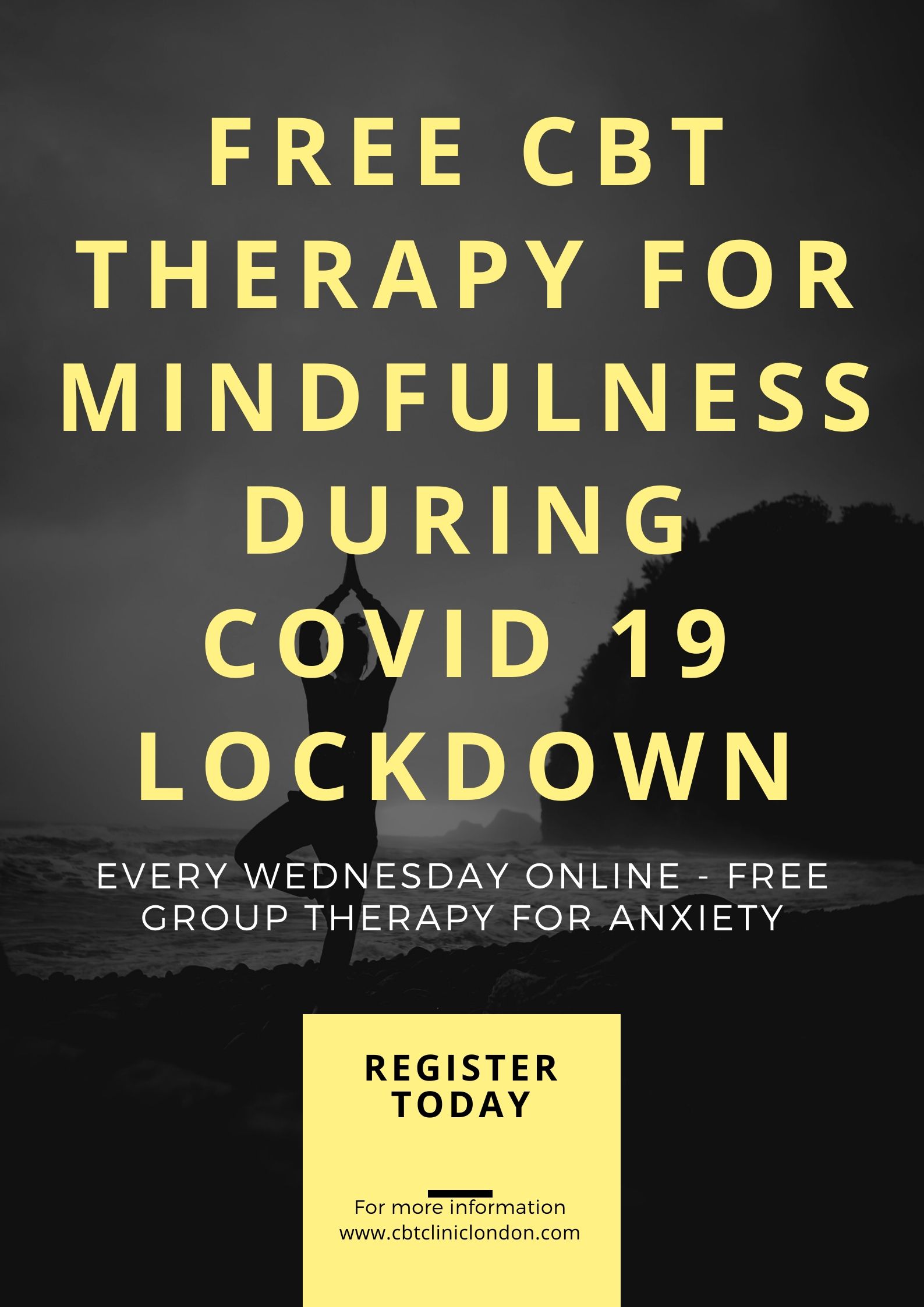
Corona Virus Anxiety London – Free Mindfulness Therapy Online Every Wednesday
Right now (April 2020) we are dealing with a very unusual, disruptive and downright scary issue. Many of us are worrying about how COVID-19 is going to affect our day to day existence, finances, our health and our future.
To feel anxious at this present time is natural. Everyone is processing this event with some level of anxiety, and everyone has different mechanisms for coping with the prospect of the Coronavirus arriving on their doorstep.
Alistair Bond from CBT Clinic London is launching a series of free online “Lunchtime Mindfulness Meditation” Classes starting on 01/04/20 from 12 pm – 1 pm. These classes are open to all and aim to help you to navigate the anxiety caused by the stressful situation we are all facing.
Book A Free Anxiety Therapy Course Online Now – Every Wednesday
Click here to book your FREE online therapy group mindfulness session now on a Wednesday that suits you.
“Everything originates from this moment. It is the only thing we have. Now more than ever, is the time to stay grounded and present”, says Alistair Bond, Mindfulness Meditation Teacher, from The CBT Clinic London.
“We need proven ways to stop our minds from jumping too far ahead into the “scary” future. In these challenging times, we must seek out practices that bring more acceptance to the problematic thoughts and feelings that accompany this new reality, we find ourselves in. I don’t know a better way to do that than engaging in Mindfulness Meditation. This is why I think it is vital for me to provide these FREE classes for anyone who wishes to learn this life-affirming and highly practical skill.”
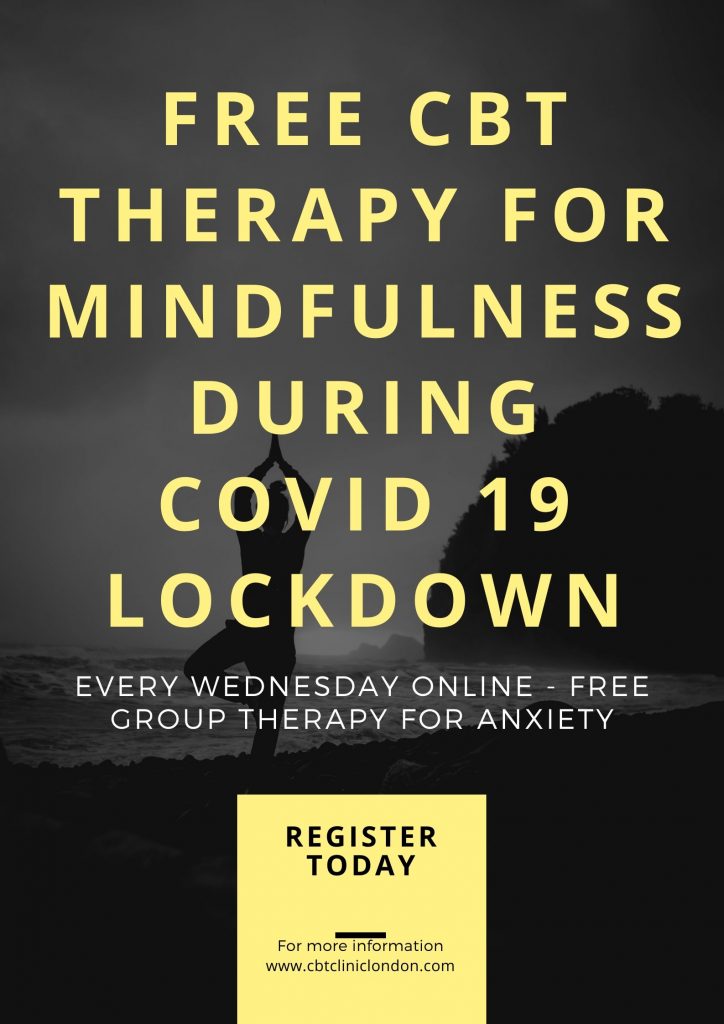
What is anxiety?
Anxiety is a natural response to high levels of stress which is often brought about by feelings of fear about the future. We all experience anxiety differently and with a varying level of ferociousness. The symptoms can build up over time and the focus of our anxiety can change. You may have a constant “sinking feeling” in the pit of your stomach, restlessness and difficulties in concentrating. Whilst others may experience, muscular tension, a racing heart, feeling hot or sweaty or difficulties with sleep.
Anxiety, if left unchecked, can build up to a point where we may experience a Panic Attack. This is where the mental anguish felt transcends into an extreme physical state and can be experienced as feeling faint, heart palpitations, chest pains, dizziness, shortness of breath or dry mouth. Often we misinterpret these symptoms and believe we are going to have a heart attack, suffer a stroke or lose our minds. Which keeps us stuck in a vicious cycle of panic.
How Does Mindfulness Help Anxiety?
In light of what we are now facing with the COVID-19 pandemic, anxiety within us could be created by so many issues. Money worries, isolation and loneliness, worrying about the wellbeing of relatives, food availability, the fear of getting or spreading illness, redundancy, your career/ business, your health or your future goals to name but a few.
There are many ways in which Mindfulness Meditation can help reduce the stress response created in our bodies and minds at times like these. By learning how to connect more deeply to the present, learning how to respond rather than react and bring a greater acceptance to our current experience, we can activate our “self – soothing” mechanism leading to an increased sense of well being inside of ourselves.
In our article about Mindfulness, we explored in more detail about the benefits of Meditation and how connecting to the present and accepting our feelings can help us gain peace within our bodies and minds.
In this unprecedented time, we are being forced to deal with an influx of new feelings and thoughts which are unfamiliar and unwelcome. The ‘noise’ we now may have to filter out is that of our own internal dialogue brought about by these feelings, as well as the constant news updates you may feel compelled to watch.
Mindfulness can help us filter this noise and forces us to carve out some space in our new and temporary regime in order to help us connect to the present and not get caught up in a future we have little or no control over.
Online Guided Meditation for Anxiety
You can join us online for our free Mindfulness Meditation classes starting on 01/04/20 from 12 pm- 1 pm. The 60-minute meditation class will be presented over Zoom (www.zoom.us) and is open to everyone. Zoom software is free to download and just takes a few minutes. To book yourself a place on our free Mindfulness Meditation classes click here.
Learn More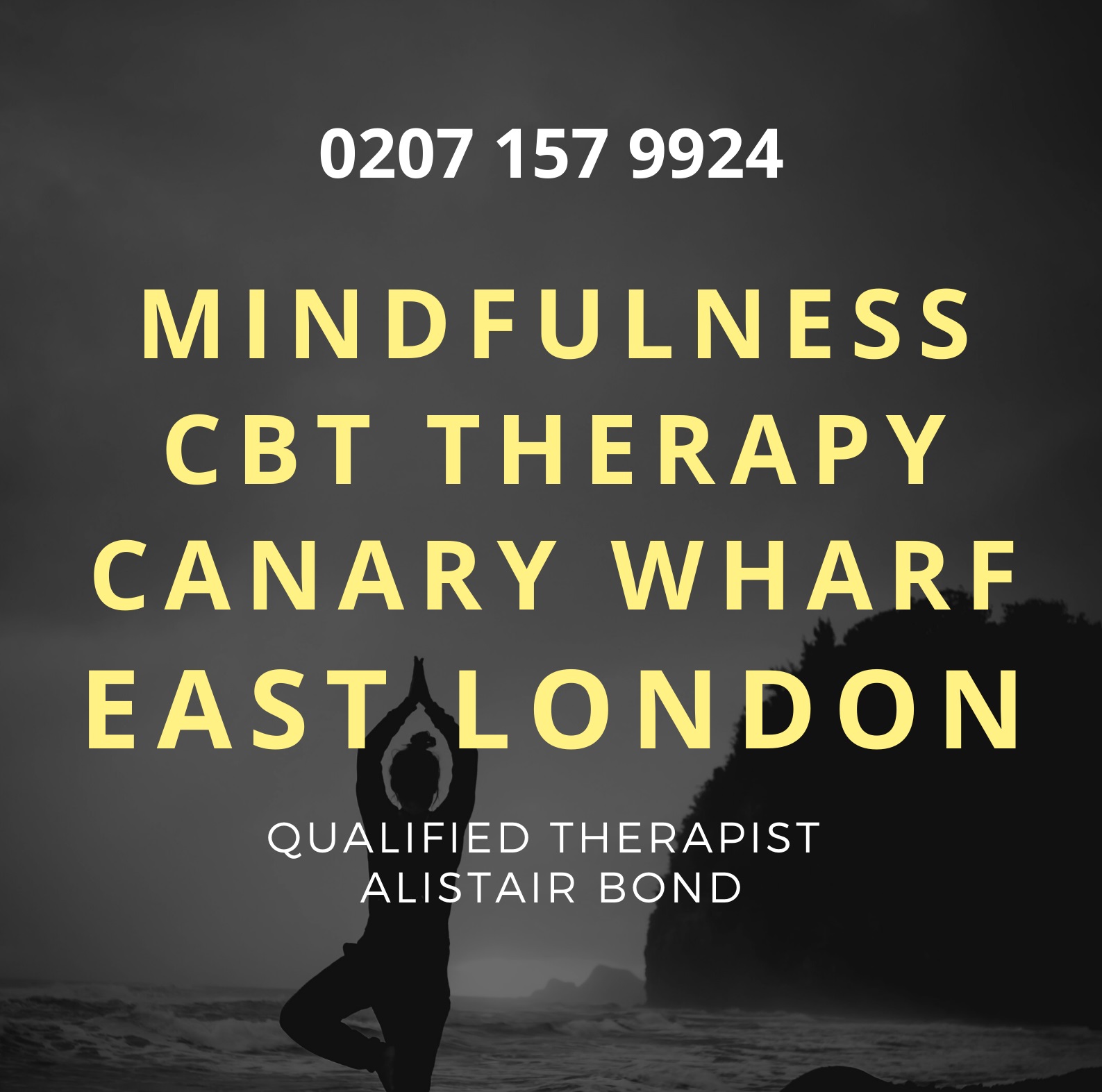
Mindfulness Meditation for Anxiety and Stress
If you are feeling stressed, anxious, have poor concentration, dwell on the past, worry excessively, are trapped in overthinking or are having trouble sleeping, you may find that mindfulness meditation will help you cope better with the pressures that everyday life can bring.
Mindfulness and meditation are separate practices, but they go hand in hand to help alleviate certain thought processes and patterns of behaviour which can cause stress or distress and are often an underlying factor in some health conditions. Mindfulness is essentially the practice of being ‘aware’ of something, such as thoughts, behaviours, feelings or movements, and the world around you. In paying attention to the present, you can make great steps to improve your overall mental well-being.
To help facilitate a state of ‘in the moment’ mindfulness meditation is practised, helping ease the mind of external influences and allowing us to focus inwards. This helps us to identify the thoughts and sensations we are experiencing and see the ‘present’ with more clarity.
Find out more about our London Based mindfulness meditation classes or to book a one-to-one session contact us on 0207 157 9924 or email info@cbtcliniclondon.com.
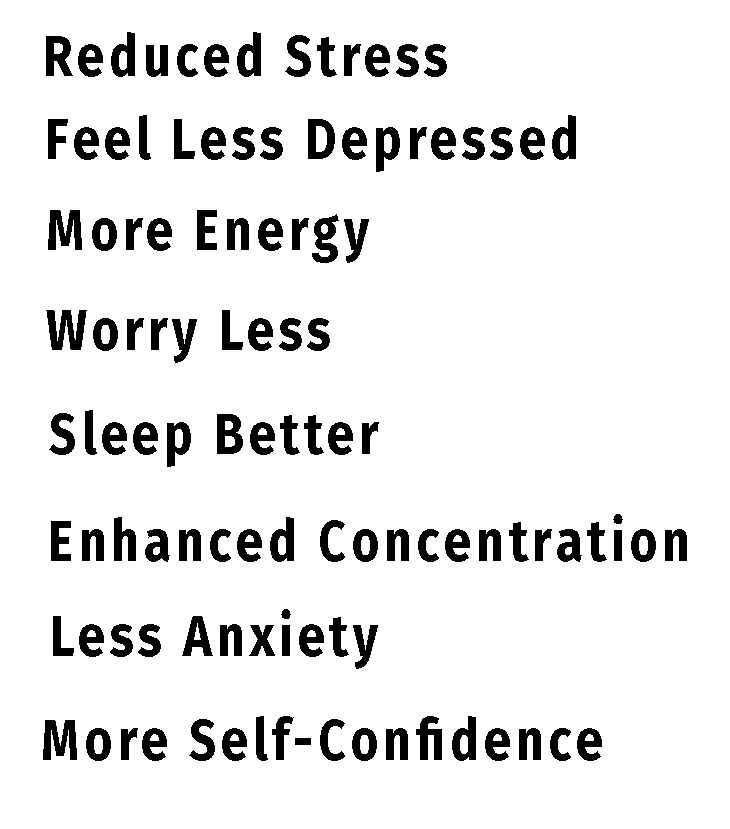
Benefits of Meditation
The benefits of mindfulness and meditation are well documented and scientifically proven. Many of our clients who work in high pressure, professional environments often have psychological challenges that they feel are holding them back or are affecting their quality of life. Issues such as anxiety, insomnia, stress, high blood pressure, low energy levels, depression, headaches & migraines, restlessness, and problems concentrating can all be managed with mindfulness and meditation techniques.
The practice of mindfulness meditation is gaining more and more recognition as a useful tool in combating issues that are born out of modern-day living. In fact, the NHS recognises mindfulness as a way to help improve mental health and well-being in adults and children alike.
Mindfulness and Meditation Courses London
Mindfulness and meditation gives us the chance to step out of our hectic lives and simply observe and listen to ourselves, our thoughts and our bodies whilst feeling at ease in our surroundings.
The CBT Clinic London is based in the Royal Foundation of St. Katherine, London, E14 8DS and we offer a non-religious, non-spiritual, purely practical approach to meditation and mindfulness.
For details about our London mindfulness classes please contact us on 0207 157 9924 or email info@cbtcliniclondon.com.
Private Sessions in Mindfulness Meditation
You can arrange a private one to one session to practice mindfulness meditation which can either take place in the clinic or remotely over Skype, Zoom or Facetime.
Some clients feel more at ease in practising in a one to one format others find practising in a small group suits them better. Either way, we can discuss the best approach to your mindfulness practice so that you feel at ease.
If your lifestyle means that fitting in a regular day or time for a group class can be challenging, then you may find that one to one sessions or the Skype/Zoom/Facetime option would suit you better.
Mindfulness Classes in London
For details about our London mindfulness classes please contact us on 0207 157 9924 or email info@cbtcliniclondon.com.
Learn More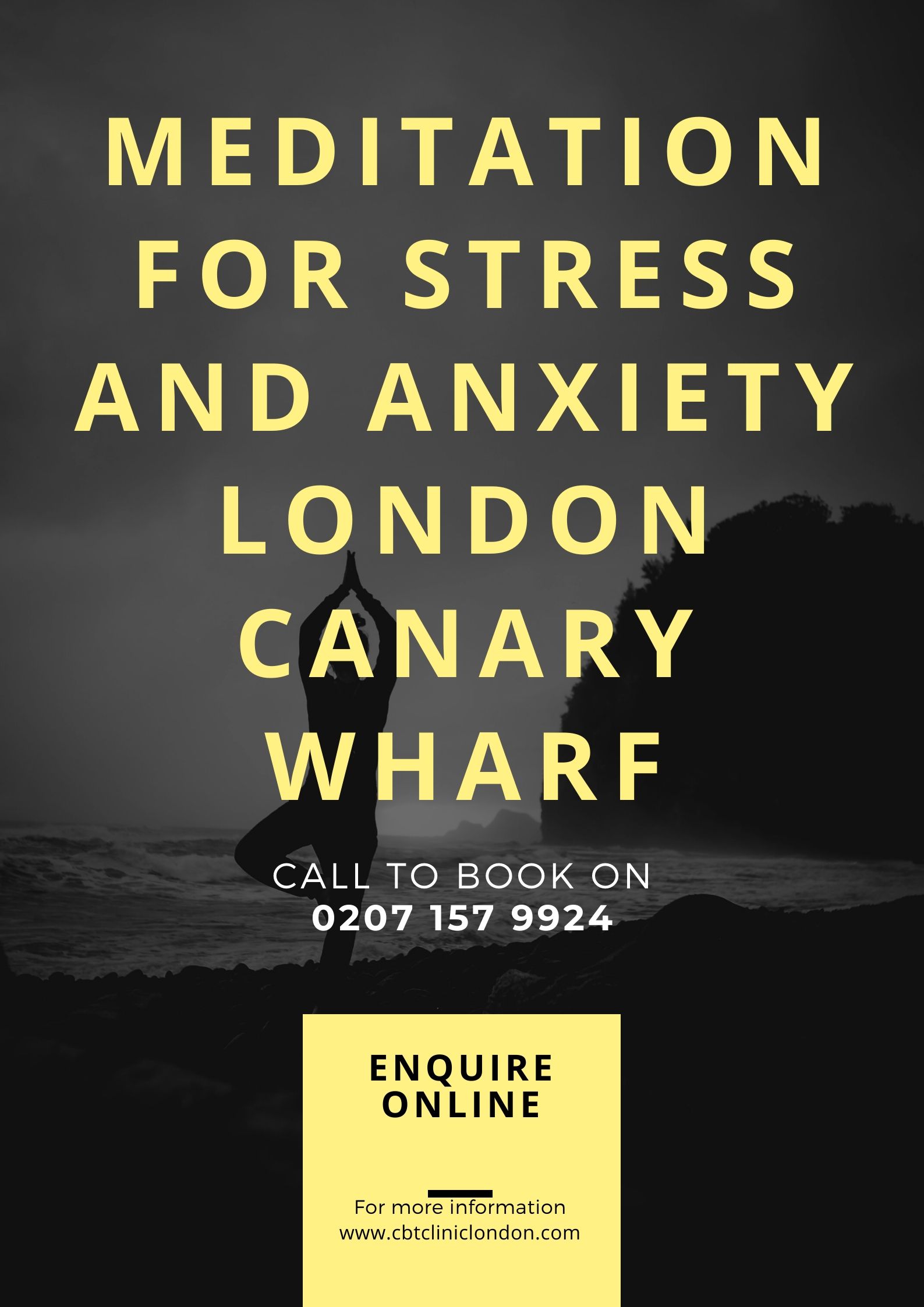
Meditation for Stress and Anxiety – Canary Wharf, East London
For information about our meditation classes in Canary Wharf, East London email our team now on info@cbtcliniclondon.com or call 0207 157 9924.
Learn MoreHow Common is Depression?
[et_pb_section admin_label=”section”]
[et_pb_row admin_label=”row”]
[et_pb_column type=”4_4″][et_pb_text admin_label=”Text”]
Depression CBT Therapy East London Canary Wharf
Despite the fact that being depressed or being in a state of depression feels like one of the most loneliest experiences out there, depression touches a huge number of individuals on a day to day basis. The World Health Organisation estimates that over one hundred and twenty million people suffer with this illness, and with up to twenty percent of people showing symptoms of depression at any one time, this proves that you are not alone.
There are a staggering amount of people across the globe who suffer, and battle, various degrees of depression at one stage or another in their lives however, statistics show that depression itself is much more commonplace in today’s society, and nobody is exempt.#]
Feeling Depressed in 2020 – A Wider Recognition
We often ask ourselves why depression is more common nowadays than it used to be back in, say, the 1940s, and the most prevailing feature is possibly an acceptance of the condition. What with the creativity of social media, particularly over the last decade, there has been a wider acknowledgement of depression, and as such, the word ‘depression’ itself has much less of a stigma attached to it.
This wider recognition has also contributed to a greater understanding of depression, and the levels of depression a person may suffer; no longer is it an illness which is kept under wraps, rather than now, it is a condition which is discussed openly within families, communities, even on your favourite daytime television programmes and soap operas.
Secondly to this stronger affirmation, we have to take a look at society as a whole. With statistics suggesting that ten times more people suffer with major depression than they did some sixty years ago, and in particular, young adults, we cannot ignore the social factors behind the constant increase in diagnoses. This increase can of course be attributed to more people going to their doctor to discuss their feelings and symptoms however, it is the case that our emotional needs are perpetually demanding to be met.
As human beings we have emotional needs, and those who are depressed are usually not getting their emotional needs met and are not receiving the emotional support needed to thrive and prosper. We seem to be living in a society today where social acceptance plays a major role in our every day lives, and all to often individuals are basing their own successes on the successes of those around them. These comparisons, without doubt, can make any character feel as though they are not good enough, that everyone else is better than them, and so on.
While there are a number of factors that can cause depression, such as a bereavement, divorce, abuse, redundancy, or money worries, there are a number of triggers that can often combine to spark the symptoms of depression, and these factors have troubled individuals since the beginning of time.
It has often been said that society breeds depression, and the expectations placed upon us at a very early age is a major contributory factor . Growing on from that, the expectations we place on ourselves through our teenage years and into adulthood, as well as what society deems ‘successful’ is proving to have a huge impact on how we feel about ourselves, making us an anxious breed.
For many, depression can be an overwhelming force; it can force us into a corner, force us to retreat, and force us to close ourselves up to the very people who want to care and help us. These days, having a wider recognition of depression has undoubtedly played a huge part in the acceptance of it, and although depression is by no means a modern condition, the triggers are constantly evolving.
CBT Therapy is the most effective treatment for the symptoms of Depression and you can find more about how we treat Depression and many other common mental health difficulties at the home of CBT Therapy – The CBT Clinic London. www.cbtcliniclondon.com.[/et_pb_text][/et_pb_column]
[/et_pb_row]
[/et_pb_section]
Chronic Pain
Chronic Pain:
The International Association for the Study of Pain (IASP) defines pain as “an unpleasant sensory and emotional experience
associated with actual or potential tissue damage, or described in terms of such damage” (IASP, 1994). Pain is a subjective
experience dependent on the self-report of the individual. For this reason, another popular definition of pain is that it is “whatever
the experiencing person says it is, existing whenever he (or she) says it does” (McCaffrey& Pasero, 1999).
One of the most important distinctions in understanding and treating pain is between acute and chronic pain. Some of the
most important differences are highlighted below:
Less than 3 months More than 3 months
Is a symptom Is a condition
Identified cause; body’s response to injury
May develop after incident;
may have known or unknown cause
Diminishes with healing and responds
Persists beyond expected healing time
to treatment and/or despite treatment
Acute pain typically occurs following an identifiable incident where an injury is sustained, such as a broken arm or sprained
ankle. It is adaptive because it results in focused attention on a situation that is threatening. Acute pain is time-limited, diminishes
with healing, and the cause usually is known. Chronic pain, on the other hand, persists beyond the expected time and indicated
point of healing, and is typically defined as longer than 3 months duration. It may be present in multiple contexts and have an
unknown or known cause (e.g., identified injury, osteoarthritis). While pain is present and may feel identical to acute pain, the
experience does not have the same meaning. More recent understandings of chronic pain suggest that when pain continues in the
absence of ongoing tissue damage, the nervous system itself is misfiring pain signals. Chronic pain, therefore, is best understo
12 Cognitive Behavioral Therapy for Chronic Pain Among Veterans
Types and Locations of Pain
Chronic pain can affect any part of the body. Because of the complexity of chronic pain, it is often difficult to categorize
conditions into clear and simplistic categories. It is useful, however, to be familiar with the most commonly used classifications,
nociceptive and neuropathic pain:
Nociceptive Pain
• Pain that is caused by damage to body tissue and is based on input by specialized nerves called nociceptors
• Nociceptors sense danger to soft tissues such as muscles, bones, ligaments, and tendons
• Most nociceptive pain is musculoskeletal, and is often described as aching or deep
Neuropathic Pain
• Pain that occurs when there is nerve damage that typically involves either the peripheral or central nerves
• It is often described as burning, shooting, tingling, or electric
Headache pain does not fall into either of the above classes but is another large category of painful conditions:
Headache Pain
• Pain that involves disturbance of sensitive structures around the brain
• Sensation is usually in the forehead, eyes, or upper back/neck areas
• Pain is often described as a tight band, pounding, throbbing, or dull
The evaluation of a patient who has chronic pain can be a complex process and various factors must be considered. First,
many Veterans have more than one type and location of pain. It is not uncommon for someone to have low back pain related to
degenerative disc disease (nociceptive) as well as diabetic neuropathy creating foot pain and numbness (neuropathic). This same
person may also have tension-type headaches several times per week. In addition, many individuals treated in the VA system have
numerous medical and psychiatric comorbidities that can create a multifaceted pain presentation. Furthermore, the etiology of a
specific pain complaint may be unknown; while some Veterans have an identified precipitating event or trauma demarcating the
onset of their pain issues, others do not. There may also be a lack of clarity regarding a specific diagnosis, something that can be
frustrating for the Veteran. While cases may be challenging for these reasons, many chronic pain patients are appropriate for
CBT-CP and can benefit from the intervention.
Therapist Manual 13
Pain Conditions
A comprehensive review of all pain locations and diagnoses is beyond the scope of this manual. Because of the previously
mentioned difficulties encountered in straightforward classification, the list below provides basic information on many conditions
encountered in VHA.
Back Pain
Low Back Pain. Low back pain (LBP or lumbago) is the most common form of pain and the most fiscally costly worldwide
in terms of medical visits and loss of work productivity (Deyo & Weinstein, 2001). Most people with acute LBP recover in a
matter of weeks but for about 10% the pain will become chronic (Costa et al., 2012). Many individuals who experience chronic
LBP report high levels of fear of movement and consequently are prone to deconditioning of the muscles leading to greater
disability. LBP may be due to factors such as herniated discs, degenerative disc disease, spinal stenosis, or arthritis, but the vast
majority of back pain is due to muscle strain (Deyo & Weinstein, 2001).
Middle and Upper Back Pain. Middle and upper back pain is less common than LBP because the bones in these areas do
not move as often. As in the lower area of the back, pain is most often related to muscle sprain or overuse, herniated discs, or
arthritic processes.
Neck Pain. Neck pain (i.e., cervicalgia) is a common issue with about 65% of the population experiencing it at some point in
their lives. It is generally caused by activities that strain the neck such as poor posture or sleeping, muscle tightness, or whiplash
from a motor vehicle accident. Neck pain may also be associated with headache pain.
Arthritis
Osteoarthritis. Osteoarthritis (OA) is the most common form of arthritis (Prieto-Alhambra & Judge, 2013) and occurs when
cartilage that cushions the ends of bones and joints deteriorates. Because of this, OA is often referred to as the “wear and tear”
disease and is common among Veterans given engagement in military and non-military occupations that often involve physical
labor (Morgenroth, Gellhorn, & Suri, 2012). The most common areas of the body affected include hands, feet, neck, low back,
knees, and hips.
Rheumatoid Arthritis. Rheumatoid arthritis (RA) is a chronic, systemic inflammatory disorder that primarily affects the
joints. White blood cells accumulate in the joints causing swelling and pain. Progression of the disease can lead to destruction of
cartilage, ligaments, and tendons. RA typically impacts functional status to a greater degree than OA and is twice as prevalent in
women than men.
Tendonitis/Bursitis. Tendonitis and bursitis involve inflammation of one of the tendons and bursae, respectively. Tendons
are thick cords that join muscles to bones and inflammation causes pain and tenderness in the joints. Tendonitis is commonly
associated with sports involving repetitive motion such as swimming or throwing a ball but can result from any repetitive
movement involving the joints. Bursae are fluid-filled sacs found in joints that surround areas where tendons, skin, and muscle
tissues meet. Bursae provide essential lubrication to the hips, knees, elbows, and heels. Damage can cause pain, swelling,
and redness.
Pelvic Floor Disorders. Pelvic floor disorders occur when the area that supports the pelvic organs becomes weak or
damaged. These may result in urinary or fecal incontinence, as well as persistent pain in the pelvic walls. Some of the
common causes are endometriosis, pelvic floor tension myalgia, pelvic inflammatory disease, fibroids, surgeries, and irritab
14 Cognitive Behavioral Therapy for Chronic Pain Among Veterans
Peripheral Neuropathic Pain. Peripheral neuropathy typically affects the hands and feet. It involves microvascular lesions
in small blood vessels and its development is often associated with high blood sugar secondary to diabetes. Pain is commonly,
but not universally, associated with peripheral neuropathy. Pain quality is often described as numb and tingling, pins and needles,
electric, or burning, as opposed to being characterized as “pain.”
Radicular Pain. Radicular pain is most commonly associated with LBP or neck pain, referred to as lumbar radiculopathy
and cervical radiculopathy, respectively. It radiates along a nerve due to inflammation or irritation of the nerve root and extends
from the spinal cord to areas such as the buttocks and down the legs in the case of back pain, or down the arms in the case of neck
pain. The sudden appearance of radicular pain, new muscular weakness, or the identification of radicular pain that is not noted by
medical providers is cause for immediate medical evaluation (Gilron, Watson, Cahill, & Moulin, 2006). Radicular pain is typically
described as burning, shooting, or shock-like (Atlas et al., 1996).
Phantom Limb Pain. A phantom limb is the sensation that an amputated or missing limb is still attached to the body.
Between 60 and 80% of individuals with an amputation experience phantom limb sensations and the majority of these sensations
are painful (Sherman, Sherman, & Parker, 1984). In addition, pain at the site of the amputation, or stump, caused by nerve damage
in the stump region is also common. Pain is variable from a dull ache to shooting and severe.
Fibromyalgia. Fibromyalgia (FM) is a disorder of unknown etiology associated with widespread pain, sleep disturbance,
fatigue, and psychological distress among other symptoms. FM pain typically includes tender “trigger” points found in soft tissue
of the back of the neck, shoulders, low back, hips, shins, and knees, and the pain is often described as a deep aching or burning.
FM is about 7 times more common in women than men (Haviland, Banta, & Prezekop, 2011) and individuals with FM are 3 times
more likely to have a comorbid diagnosis of major depression than individuals without FM.
Complex Regional Pain Syndrome. Complex regional pain syndrome (CRPS), previously known as reflex sympathetic
dystrophy syndrome or RSD, is a poorly understood pain condition that often starts after a minor injury or complication, usually
to a hand, arm, foot, or leg, and often spreads. Type 1, the form most commonly seen, has no demonstrable nerve lesions
while there is nerve damage in Type 2. Pain is described as severe and changes in the appearance and texture of the skin are
often noticeable.
Types of Headaches
The most common types of headaches are listed below. It is important to remember, however, that patients may have more
than one kind of headache (e.g., tension-type headaches a few times per week and migraines a few times per month). In addition,
in the same way that other pain locations may be difficult to classify, Veterans may present with mixed symptoms that do not fall
neatly into one category.
Tension-type. Tension-type headaches (TTH) are by far the most common type, accounting for over half of all headaches
(ICHD, 2nd edition, 2004). The primary sensation associated with TTH is the feeling of a tight-band wrapped around one’s head.
These range in intensity from mild to moderate and also range in frequency from episodic to chronic. Criterion for chronic TTH is
met when an individual experiences headaches for 15 days a month for at least 6 months (ICHD, 2nd edition, 2004).
Migraine. Migraine headaches occur in about 10% of the population at some point in their lifetime (Rasmussen, Jensen,
Schroll, & Olesen, 1991). They are classified as either with or without aura, defined by symptoms such as sensory or motor
disturbance that precede or accompany the headache. Migraine headaches tend to be recurrent and are associated with a number
of autonomic nervous system symptoms. The typical migraine headache is unilateral and pulsing in nature, lasts from 2 to 72
hours and may be associated with nausea, vomiting, sensitivity to light and sound, and aggravated by physical activity. Migraines
are 2 to 3 times more common in women than men (ICHD, 2nd edition, 2004).
Cluster. Cluster headaches involve severe unilateral pain that is orbital, supraorbital, or temporal, lasting 15 to 180 minutes,
and occurring in frequency from every other day to up to 8 times per day (ICHD, 2nd edition, 2004). Painful episodes may be
accompanied by tearing, nasal congestion, sweating, a drooping eyelid, or a contracted pupil. These all occur on the affected side
of the face. The intense pain of cluster headaches is due to dilation of blood vessels creating pressure on the trigeminal nerve.
However, the underlying cause of the dilation is not understood. This type of headache is much less common, affecting .1% of the
population, and is 3 to 4 times more common in men than women (ICHD, 2nd edition, 2004).
Therapist Manual 15
Post-traumatic. Headaches associated with head trauma (e.g. mild to severe traumatic brain injury) is common immediately
following an injury, with a prevalence up to 90%. Up to 44% of patients report continued headaches 6 months following an injury
(Nicholson & Martelli, 2004). The three most common presentation patterns are tension-type, migraine type, or cervicogenic
(Gironda et al., 2009). Exposure to blasts and concussions while deployed make this type of headache more common among
Veterans and military Servicemembers.
Medication Overuse. Medication overuse headaches, previously known as rebound headaches, are a secondary cause of
chronic daily headaches due to the overuse of acute headache analgesics. Overuse is defined by treatment days per month and
depends on the drug. Overuse is often motivated by the desire to treat headaches or a fear of future headaches, but regardless can
make headaches refractory to preventative medications (Silberstein, Lipton, & Saper, 2007).
Treatment Options for Chronic Pain
The following section provides an introduction to interventions for pain management that Veterans may receive. The intent of
this section is to familiarize non-medical providers with common treatment modalities by providing basic information that does
not include data on efficacy.
Analgesic Medications
The following section is an introduction to analgesic, or pain relieving, medications. It is not meant to guide prescription of
medications but instead to help providers understand the likely uses of medications taken by Veterans with chronic pain. A table
of medications including both generic and brand names is also included (Figure 1).
Non-Opioid Analgesics. Aspirin and other related compounds constitute a class of drugs known as nonsteroidal antiinflammatory
drugs (NSAIDS). This class of medication produces three desirable effects including anti-inflammatory, analgesic,
and antipyretic (fever reducing). Commonly used medications in this category include aspirin, ibuprofren, naproxen, etolodac,
meloxicam, and piroxicam. The most common adverse effects of NSAIDs are gastrointestinal and renal (kidney). Acetaminophen
is also a non-opioid analgesic but is not an NSAID because, though possessing pain relieving and antipyretic properties, it lacks
an anti-inflammatory effect.
Opioid Analgesics. Opioid analgesics (or narcotics) refer to compounds that act by binding to opioid receptors in the
brain. Though often used interchangeably, the term opiate refers only to the naturally occurring resin found in opium poppy
while opioids also include synthetically produced substances and thus is the preferred general term. This class of medications
can either be short- or long-acting. Commonly used opioids include morphine, hydrocodone, oxycodone, codeine, methadone,
and hydromorphone. The analgesic effects of opioids are due to decreased perception of pain, decreased reaction to pain, and
increased pain tolerance. The most commonly cited side effects of opioids (in order of frequency reported) include nausea,
constipation, drowsiness, dizziness, and vomiting (Eisenberg, McNicol, & Carr 2006). Opioids may be associated with risk of
misuse (Comptom & Volkow, 2006) and physiological dependence. Measuring the risk to benefit ratio of opioid therapy for
patients with chronic pain is complicated and prescribing providers are encouraged to follow the 2010 VA/Department of Defense
(DoD) Clinical Practice Guideline for the Management of Opioid Therapy for Chronic Pain. (see http://www.healthquality.va.gov/
16 Cognitive Behavioral Therapy for Chronic Pain Among Veterans
Muscle Relaxants. Muscle relaxants (or spasmolytics, antispasmodic) are most commonly prescribed for LBP, neck pain,
fibromyalgia, and tension headaches in situations where muscular contractions appear to be a prominent component of pain.
Muscle relaxants used most commonly in VA include cyclobenzaprine, tizanidine, baclofen, and methocarbamol. Muscle relaxants
work by inhibiting the central nervous system, which contributes to the commonly reported side effect of sedation and the
recommendation against driving or operating heavy machinery. Other common side effects include dizziness, headache, nausea,
irritability, and nervousness. Muscle relaxants also pose a risk of physiological dependence.
Adjuvant Analgesics. Adjuvant analgesics, or co-analgesics, are medications that were originally developed and marketed
for uses other than analgesia and are also used in pain management. The two most common classes of medications that fall
into this category are certain types of antidepressants and anticonvulsants. Antidepressants commonly used for analgesic
purposes include duloxetine, venlafaxine, and nortriptyline. Anticonvulsants, primarily used to relieve neuropathic pain, include
gabapentin, pregablin, topiramate, and lamotrigine. Common side effects of antidepressants include nausea, vomiting, insomnia,
decreased sex drive, and constipation. Common side effects of anticonvulsant medications include dizziness, fatigue, weight gain,
and drowsiness.
Headache Analgesics. Analgesics used to treat headaches vary widely and do not fall into a neat class. Migraine medications
are generally categorized by nature of their action into those that are preventative (e.g., propranolol, topiramate or Topamax),
abortive (e.g., sumatriptan or Maxalt), and rescue (butalbital/acetaminophen/caffeine or Fioricet). Of note, medication overuse
headaches, or rebound headaches, may occur when excessive analgesics are taken for headache relief, leading to chronic daily
headaches of a different type.
Figure 1. Medications for Pain
Category Generic Name(s)
Not capitalized
Brand Name(s)
Capitalized
Nonsteroidal Anti-Inflammatory
Drugs (NSAIDs)
aspirin, acetylsalicylic acid (i.e., ASA) Bayer Aspirin
celecoxib Celebrex
etodolac Lodine
ibuprofen Advil Motrin
meloxicam Mobic
naproxen Aleve Naprosyn
piroxicam Feldene
salsalate
Analgesic and Antipyretic acetaminophen (i.e., APAP) Tylenol
Opioid Analgesics codeine
codeine + acetaminophen Tylenol #3
duragesic Fentanyl patch
hydrocodone + acetaminophen Vicodin
Norco
Lortab
Lorcet
hydromorphone Dilaudid
methadone
morphine MS Contin
Therapist Manual 17
Figure 1. Medications for Pain (continued)
Opioid Analgesics (continued) oxycodone Oxycontin
oxycodone + acetaminophen Percocet
oxymorphone Opana
Opioid and Antidepressant tramadol Ultram
Muscle Relaxants baclofen
cyclobenzaprine Flexeril
methocarbamol Robaxin
tizanidine Zanaflex
Topical Analgesics capsaicin cream/patch
diclofenac gel Voltaren
lidocaine
gel/cream/ointment/ patch Lidoderm
menthol-methylsalicylate cream
Adjuvant Analgesics: Anticonvulsants carbamazepine Tegretol
gabapentin Neurontin
pregablin Lyrica
topiramate Topamax
lamotrigine Lamictal
Adjuvant Analgesics: Antidepressants amitriptyline Elavil
duloxetine Cymbalta
nortriptyline Pamelor
venlafaxine Effexor
Headache Analgesics butalbital + acetaminophen + caffeine Fioricet
rizatritpan Maxalt
sumatriptan Imitrex
zolmitriptan Zomig
Invasive Medical Treatment Options for Chronic Pain
Epidural Steroid Injections. Epidural Steroid Injections (ESIs) are used for back pain complaints associated with conditions
such as spinal stenosis or spinal disc herniation. ESIs include a combination of corticosteroids and local anesthesia that is injected
into the epidural space around the spinal cord and nerves. The injection may be guided by fluoroscopy or x-ray. The effects of the
injection last from one week to six months.
Nerve Blocks. Nerve blocks (aka, regional nerve blockade) are used for pain in the neck, back, feet or even the head. Nerve
blocks may include local anesthetic and epinephrine, with corticosteroids, and/or opioids that are injected directly into the nerve
group associated with reported pain. Nerve blocks can be used to treat painful conditions, to determine sources of pain, or to judge
the benefits of more permanent treatments such as surgery.
18 Cognitive Behavioral Therapy for Chronic Pain Among Veterans
Trigger Point Injections. Trigger point injections (TPI) are used to relieve muscles where knots form when muscles do not
relax. TPI is used in many muscle groups ranging from arms, legs, low back, and neck and is most associated with treatment of
fibromyalgia and tension headache. The injection contains a local anesthetic that may include a corticosteroid.
Facet Injections. Facet injections are used for those with chronic neck or back pain caused by inflamed facet joints,
which are located between each set of vertebrae in the spine from the neck to the tailbone. A mixture of local anesthetic and
corticosteroid medication is injected into the facet joint to reduce swelling and inflammation around the facet joint space.
Radiofrequency Ablation. Radiofrequency ablation (RFA) is used to treat severe chronic low back pain. Radiofrequency
waves produce high heat on specifically identified nerves surrounding the facet joints in the lumbar spine, ablating the nerves and
destroying their ability to transmit pain signals. RFA is an outpatient procedure using local anesthesia. While the procedure may
provide pain relief, in most patients the nerves regenerate.
OnabotulinnumtoxinA (Brand name: Botox). Botox injections are typically used for relief of frequent migraine headaches.
Botox received approval from the FDA as a treatment for chronic migraines in 2010.
Spinal Cord Stimulator. The most common use of spinal cord stimulators (SCS) is with patients diagnosed with failed back
syndrome (see definition under Surgery below). A SCS includes electrodes implanted in the epidural space, an electrical
pulse generator implanted in the lower abdominal area of gluteal region, connecting wires to the generator, and a generator
remote control.
Intrathecal Pump. An intrathecal pump is an implantable device that delivers pain medication directly to the spinal fluid.
Common medications used in pumps include baclofen or morphine. The pumps deliver medications at higher dosages than
possible with oral medications.
Surgery. Surgery may be offered for various pain locations such as back, neck, knee, shoulder, or ankle. Surgery for chronic
pain is usually considered only after conservative treatments have failed or if seen as medically necessary.
Individuals who have undergone one or more unsuccessful back surgeries may receive the diagnosis or label of “failed back
syndrome” or “failed back surgery syndrome.” Causes for failure of surgery vary but the results can lead to frustration and distrust
of medical providers, increased depression, and increased perceptions of disability (Onesti, 2004).
Non-Invasive Treatment Options for Chronic Pain
Physical Therapy. Reduction in bodily movement that can be related to fear of pain or re-injury is common in chronic pain
and often leads to physical deconditioning and, subsequently, increased pain. Physical therapy is an integral part of chronic pain
interventions as it helps restore physical functioning and reengagement in rewarding life activities. Physical therapy involves
a range of activities including stretching exercises, strengthening exercises, and use of graded exercise techniques such as
therapeutic pools or stationary bikes, in addition to a range of palliative therapies such as spinal manipulation and ultrasound,
among others.
Cold/Heat. Application of cold and heat are often used for the management of chronic pain. Cold and heat may decrease
sensitivity to pain and provide competing sensory central nervous system input that can reduce pain sensations.
Transcutaneous Electrical Nerve Stimulation (TENS). TENS units stimulate nerves by introducing a mild electrical
current. The electric current is not strong enough to cause muscle contraction but, instead, is thought to interfere with the
transmission of pain signals to the brain. Electrodes are placed on the skin and a battery-powered unit is carried or worn on the
person. No surgical procedures are involved in the use of a TENS unit.
Complementary and Alternative Therapies (CAM)
Chiropractics. These interventions primarily focus on spinal adjustment or adjustment to other joint areas. Spinal or other
joint manipulations involve a dynamic thrust that causes an audible release and attempts to increase range of motion.
Therapist Manual 19
Chiropractic care may also involve soft tissue therapy, strength training, dry needling, functional electrical stimulation, traction,
or nutritional recommendations.
Acupuncture. Acupuncture involves the insertion of needles into acupuncture points in the skin in an effort to relieve pain.
Acupuncture produces physiologic effects that are relevant to analgesia; however, the mechanism for how acupuncture affects
chronic pain remains unclear (Vickers, Cronin, et al., 2012).
Yoga/Tai Chi. Yoga and Tai Chi may provide a source of graded physical exercise combined with relaxation to improve
chronic pain.
Biofeedback. Biofeedback involves gaining greater awareness of physiological functions or processes such as muscle tone,
skin conduction, heart rate, or brainwaves. Awareness of different physiological processes is gained through use of a variety of
types of monitoring devices specific to the process being monitored, such as an electromyography (EMG) to measure muscle
activity or electrodermograph to register skin conductance or resistance. Information on a specific process is gathered, amplified,
and displayed (fed back) to the patient who then uses the visual or auditory feedback to gain control over the targeted behavior.
Biofeedback has been used to treat a variety of chronic pain disorders but is most often used in the management of headaches.
Relaxation Training. Relaxation training, which may be done in the context of biofeedback, focuses on identifying tension
within the body and applying systematic techniques for decreasing that tension. The most common techniques, which
will be described in detail later in this manual, include diaphragmatic (or deep) breathing, progressive muscle relaxation,
and visualization.
Selected Psychological Approaches
Operant Behavioral Therapy. The operant-behavioral formulation of chronic pain by Fordyce (1976) marked a significant
development in the understanding and treatment of chronic pain by introducing the concept of pain behaviors. These refer to
forms of communication that are observable expressions of pain and suffering such as moaning, clenching, grimacing, sighing,
or limping. The model suggests that reinforcement of such behaviors, often by those in one’s social environment, could lead to
maintenance of subjective reports of pain and increased self-perceptions of disability.
Cognitive Behavioral Therapy (CBT). CBT helps individuals resolve their problems concerning maladaptive emotions,
behaviors, and cognitions through a goal-oriented, systematic process. While it was originally used for treatment of those with
depression and anxiety disorders, it has been used with a variety of other conditions from insomnia to substance abuse. Since
this manual is focused on CBT-CP, a more in depth review of its application to chronic pain follows in the next section (History,
Components, and Support).
Acceptance and Commitment Therapy (ACT). Acceptance and Commitment Therapy, (ACT: Hayes et al., 1999) is
an acceptance- and mindfulness-based intervention that teaches patients to observe and accept thoughts and feelings without
judgment and without trying to change them. It focuses on identifying core values and behaving in accordance with those values.
As applied to chronic pain, ACT emphasizes that while the physical sensation may be painful, the patient’s struggle with pain
is what causes suffering and emotional distress (Dahl & Lundgren, 2006). The aim of therapy, therefore, is to develop greater
psychological flexibility in the presence of thoughts, feelings, and behaviors associated with pain.
Hypnotherapy. Hypnotherapy utilizes suggestive statements made by a therapist to alter the patient’s attention and focus
away from pain. Deep breathing is often used as a behavioral cue in the effort to alter the subjective experience of pain, however
there is significant variation in specific techniques.
Mindfulness. Mindfulness meditation is another approach combining elements of relaxation and hypnotherapy, which
seeks to increase focused attention and facilitate relaxation. Based in Theravada Buddhism, it seeks to increase intentional selfregulation
to what is occurring in the present without attaching negative associations. As applied to pain management, a primary
goal is to separate the pain sensation from unhelpful thoughts.
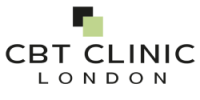
OCD Therapy CBT Private Clinic East London
OCD Therapy CBT Private Clinic East London
Obsessive-Compulsive Disorder or OCD is a common, chronic and long-lasting disorder of the brain in which an individual has uncontrollable, reoccurring thoughts [obsessions] and behaviours [compulsions] that he or she feels the urge to repeat. The disorder can be treated with medication, psychotherapy or a combination of both. Some individuals respond well to treatment, whereas some continue to experience symptoms. Some individuals with OCD can have other mental disorders, such as anxiety, depression and body dysmorphic disorder.
Obsessive-Compulsive Disorder and CBT Therapy Treatment
We welcome telephone enquiries in the first instance, call our offices on 0207 157 9924 we are closed on Sundays. Opening hours: Monday 8am–9pm, Tuesday 8am–9pm, Wednesday 8am–9pm, Thursday 8am–9pm, Friday 8am–9pm, Saturday 10am–5pm.) or you can send us a message via the Contact Form online.
Age, Sex and Obsessive-Compulsive Disorder Diagnosis
Obsessive-Compulsive Disorder can affect adults, adolescents and children. Most individuals are diagnosed by the age of 19, typically there is earlier onset in boys than in girls, but onset after the age of 35 can happen.
It is common for all individuals to double check things at times however those individuals with Obsessive-Compulsive Disorder cannot control their throughts or behaviour, even when such thoughts and behaviours have been recognised as excessive. Individuals with Obsessive-Compulsive Disorder have symptoms of obsessions, compulsions, or both and they can interfere with every aspect of daily life, from work, to school and personal relationships.
OCD Common Obsessions: Obsessions are repeated thoughts, urges, or mental images that can cause the individual anxiety:
- Fear of germs or contamination
- Unwanted forbidden or taboo thoughts, involving sex, religion and harm
- Aggressive thoughts towards the self or others
- Having things symmetrical or in a perfect order
Individuals with OCD do not want to have these thoughts and can find them disturbing. In most cases individuals with OCD realise that these thoughts do not make sense. These obsessions are typically accompanied by intense and uncomfortable feelings such as fear, disgust, doubt, or a feeling that things have to be done in a way that is just right. These obsessions are time consuming and can get in the way of important daily tasks.
Compulsions are repetitive behaviours than an individual with Obsessive-Compulsive Disorder feels the urge to do in response to an obsessive thought:
- Excessive cleaning and/or hand-washing
- Ordering and arranging things in a particular, precise way
- Repeatedly checking on things, such as checking to see if the dor is locked, or that the oven is turned off
- Compulsive counting
Compulsions are behaviours or thoughts that an individual uses with the intention of neutralising, counteracting, or making their obsessions go away. Individuals with OCD realise that this is only a temporary solution but without a better way to cope they often rely on their compulsions as a temporary escape. These compulsions are time consuming and can get in the way of important daily tasks.
These individuals often spend at least an hour a day on such thoughts or behaviours, they do not get pleasure when performing such behaviours or rituals but they may feel brief relief from the anxiety the thoughts may be causing them, and they can experience significant problems in their daily lives due to those thoughts and behaviours. A tic disorder can also be common with some individuals with Obsessive-Compulsive Disorder. Motor tics are sudden, brief and repetitive in nature such as eye blinking, facial movements, shoulder shrugging or head jerking. Common vocal tics can include repetitive throat clearing, sniffing or grunting.
Canary Wharf OCD Private Therapy CBT Clinic
These symptoms can come and go, ease over time or become worse. CBT Therapy is the most effective treatment for the symptoms of OCD and you can find more about how we treat OCD and many other common mental health difficulties with us here in Canary Wharf.

